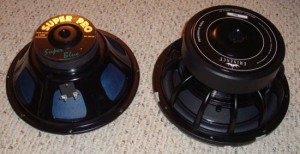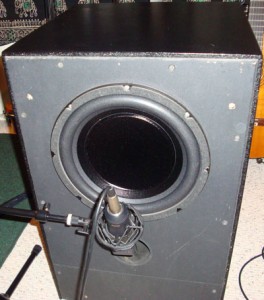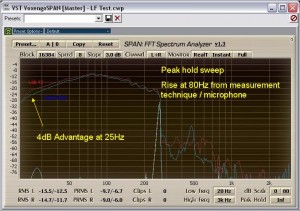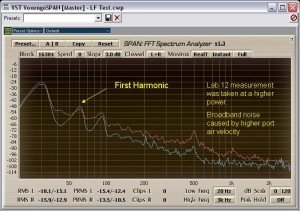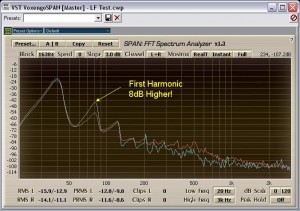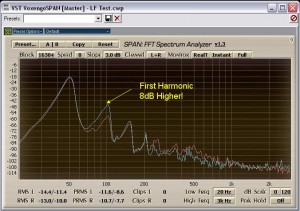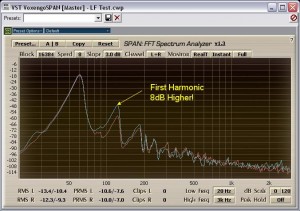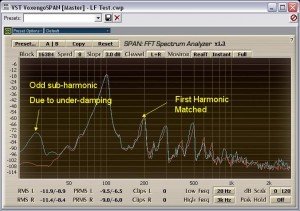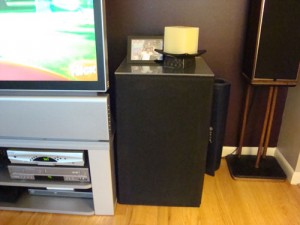Subwoofer Upgrade Project
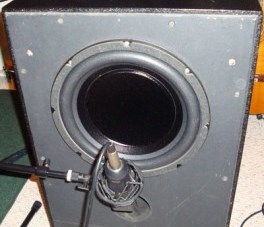
Cabinet Design
The original cabinet was built about 1990 with one design goal in mind. Large cabinet volume = low frequency extension. With about 4.4 cubic feet of internal volume this box was meant to allow a woofer to freely produce some serious low frequencies. There were a few notable points when the cabinet was built:
- Extra large!
- Medium Density Fiberboard construction for low resonance
- Unfortunately, thinner wood was used than ideal (5/8″) to keep weight and cost down
- Cabinet was later braced with hardwood strips to increase rigidity, compensating for the thin wood. The baffle was replaced with 3/4″ MDF for better mounting of the woofer.
- The cabinet is ported with a 3.5″ cardboard tube and tuned to 23Hz
In new design and construction, 3/4″ wood should be the minimum for a good subwoofer. The subwoofer amplifier in this particular design is no longer available, but for a plethora of options, check Parts Express
Driver Choice
The driver available at the time was a Pyramid Super Blue 12″ model. Very inexpensive and designed for small cabinets in a automotive application. This was used in the box for 15 years, but it was time to upgrade to a proper driver that better matched the cabinet. The old woofer problems were:
- Way too large of a box for the woofer, causing a heavy under-damped condition
- The woofer would bottom out with only 30 watts in the mid-20Hz range
- Poor cone control = higher distortion
- However, it did in fact produce some big lows!
An upgraded woofer was chosen based on software analysis to eliminate the under-damped condition and extend the frequency response to as close to 20Hz as possible without re-tuning the cabinet.
The choice: the Eminence Lab 12
On the left, the Pyramid Super Blue and on the right, the Eminence Lab 12. Now that’s a woofer!
This woofer was simply dropped in place of the old and sealed up
Measurement and Analysis
To evaluate the before and after performance of the subwoofer, I measured actual output using software tools:
- A 60 second, 20-280Hz tone sweep was created using Sound Forge
- The test tone was imported into Sonar for output to the sub
- Sweeps were recorded using close mic technique to capture the sub performance with as little room interaction as possible
- A high quality large diaphragm condenser microphone was used as the measurement device. This isn’t as good as a calibrated reference mic, but would do fine for relative measurement.
- A FFT spectrum analyzer (Voxengo SPAN) was used to analyze the recorded outputs.
Wait, what’s “close mic” technique?
Close mic technique is common in speaker analysis and involves placing the measurement microphone within 6 inches from the speaker. This takes care of several problems when measuring low frequencies:
- Room response has a huge effect on low frequencies, placing the mic close to the woofer measures the speaker itself without the room
- The port and cone measurements can be taken separately and averaged, or the mic must be placed between the port and cone to attempt to capture both
- The measurement distance is approximate, and some adjustment may be necessary to get a good result.
There were a couple limits to this technique:
- Measurement is dependent on the performance of the microphone and any proximity effect caused by placing the mic within inches of the speaker.
- I did not have a measurement point on the actual voltage going to the driver, so power levels were not controlled during the comparison. This leads to some variation on noise and distortion levels.
Measurement Results
Frequency Response
Frequency response was surprisingly similar between the woofers. There is a distinct 4dB advantage at 25Hz with the Lab 12 woofer. The real advantage becomes apparent when looking at the distortion of the woofers by watching the harmonic content.
Harmonic Distortion 30Hz
At 30Hz the Lab 12 woofer is already showing an advantage in harmonic distortion, in spite of a large disadvantage caused by the higher power input during measurement.
Harmonic Distortion 40, 50, and 60Hz
All measurements across the subwoofers intended range show the Lab 12 woofer has a huge advantage with a much lower harmonic output. The difference in the first harmonic was about 8dB across the band.
Harmonic Distortion at 100Hz
An interesting anomaly occurred as the Super Blue woofer approached 100Hz. A 1/4 sub-harmonic appeared. This is most likely due to the heavily under-damped condition the woofer was operating under. The cone was out of control!
Conclusion
The upgrade is a success! Even if my wife doesn’t care one bit and only 5% of anything I ever play through this beast of a subwoofer demonstrates the improved output, I feel the data speaks for itself and I have one hell of a woofer. After applying the grill and putting in it’s natural habitat, it can go back to a life of patiently waiting for that 25Hz signal to wake it from it’s sleep.

